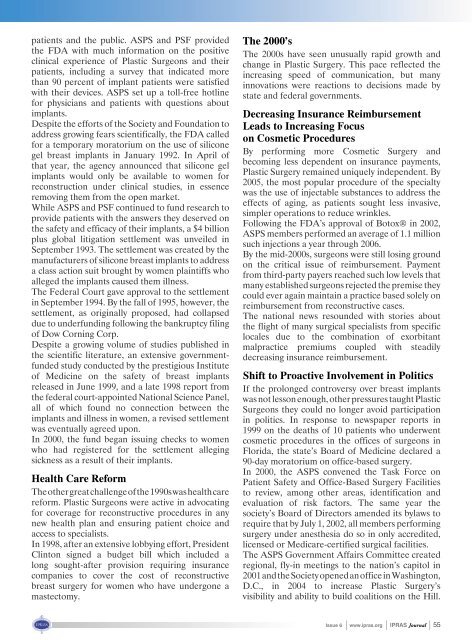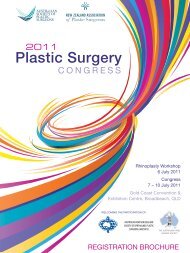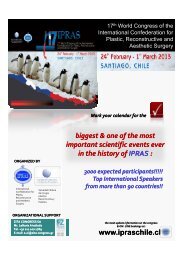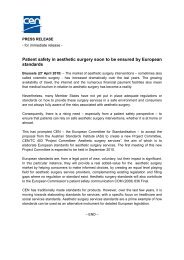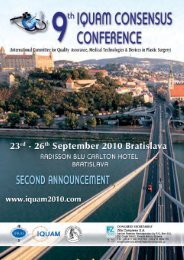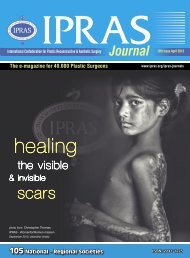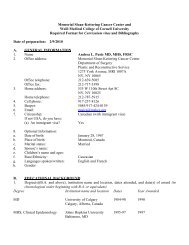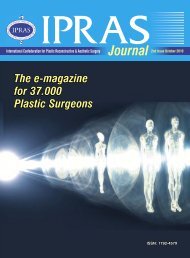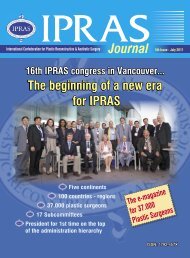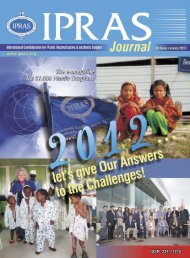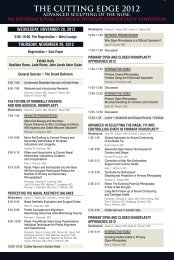Download pdf file - IPRAS
Download pdf file - IPRAS
Download pdf file - IPRAS
- No tags were found...
Create successful ePaper yourself
Turn your PDF publications into a flip-book with our unique Google optimized e-Paper software.
patients and the public. ASPS and PSF providedthe FDA with much information on the positiveclinical experience of Plastic Surgeons and theirpatients, including a survey that indicated morethan 90 percent of implant patients were satisfiedwith their devices. ASPS set up a toll-free hotlinefor physicians and patients with questions aboutimplants.Despite the efforts of the Society and Foundation toaddress growing fears scientifically, the FDA calledfor a temporary moratorium on the use of siliconegel breast implants in January 1992. In April ofthat year, the agency announced that silicone gelimplants would only be available to women forreconstruction under clinical studies, in essenceremoving them from the open market.While ASPS and PSF continued to fund research toprovide patients with the answers they deserved onthe safety and efficacy of their implants, a $4 billionplus global litigation settlement was unveiled inSeptember 1993. The settlement was created by themanufacturers of silicone breast implants to addressa class action suit brought by women plaintiffs whoalleged the implants caused them illness.The Federal Court gave approval to the settlementin September 1994. By the fall of 1995, however, thesettlement, as originally proposed, had collapseddue to underfunding following the bankruptcy filingof Dow Corning Corp.Despite a growing volume of studies published inthe scientific literature, an extensive governmentfundedstudy conducted by the prestigious Instituteof Medicine on the safety of breast implantsreleased in June 1999, and a late 1998 report fromthe federal court-appointed National Science Panel,all of which found no connection between theimplants and illness in women, a revised settlementwas eventually agreed upon.In 2000, the fund began issuing checks to womenwho had registered for the settlement allegingsickness as a result of their implants.Health Care ReformThe other great challenge of the 1990s was health carereform. Plastic Surgeons were active in advocatingfor coverage for reconstructive procedures in anynew health plan and ensuring patient choice andaccess to specialists.In 1998, after an extensive lobbying effort, PresidentClinton signed a budget bill which included along sought-after provision requiring insurancecompanies to cover the cost of reconstructivebreast surgery for women who have undergone amastectomy.The 2000’sThe 2000s have seen unusually rapid growth andchange in Plastic Surgery. This pace reflected theincreasing speed of communication, but manyinnovations were reactions to decisions made bystate and federal governments.Decreasing Insurance ReimbursementLeads to Increasing Focuson Cosmetic ProceduresBy performing more Cosmetic Surgery andbecoming less dependent on insurance payments,Plastic Surgery remained uniquely independent. By2005, the most popular procedure of the specialtywas the use of injectable substances to address theeffects of aging, as patients sought less invasive,simpler operations to reduce wrinkles.Following the FDA’s approval of Botox® in 2002,ASPS members performed an average of 1.1 millionsuch injections a year through 2006.By the mid-2000s, surgeons were still losing groundon the critical issue of reimbursement. Paymentfrom third-party payers reached such low levels thatmany established surgeons rejected the premise theycould ever again maintain a practice based solely onreimbursement from reconstructive cases.The national news resounded with stories aboutthe flight of many surgical specialists from specificlocales due to the combination of exorbitantmalpractice premiums coupled with steadilydecreasing insurance reimbursement.Shift to Proactive Involvement in PoliticsIf the prolonged controversy over breast implantswas not lesson enough, other pressures taught PlasticSurgeons they could no longer avoid participationin politics. In response to newspaper reports in1999 on the deaths of 10 patients who underwentcosmetic procedures in the offices of surgeons inFlorida, the state’s Board of Medicine declared a90-day moratorium on office-based surgery.In 2000, the ASPS convened the Task Force onPatient Safety and Office-Based Surgery Facilitiesto review, among other areas, identification andevaluation of risk factors. The same year thesociety’s Board of Directors amended its bylaws torequire that by July 1, 2002, all members performingsurgery under anesthesia do so in only accredited,licensed or Medicare-certified surgical facilities.The ASPS Government Affairs Committee createdregional, fly-in meetings to the nation’s capitol in2001 and the Society opened an office in Washington,D.C., in 2004 to increase Plastic Surgery’svisibility and ability to build coalitions on the Hill.Issue 6 www.ipras.org <strong>IPRAS</strong> Journal 55


